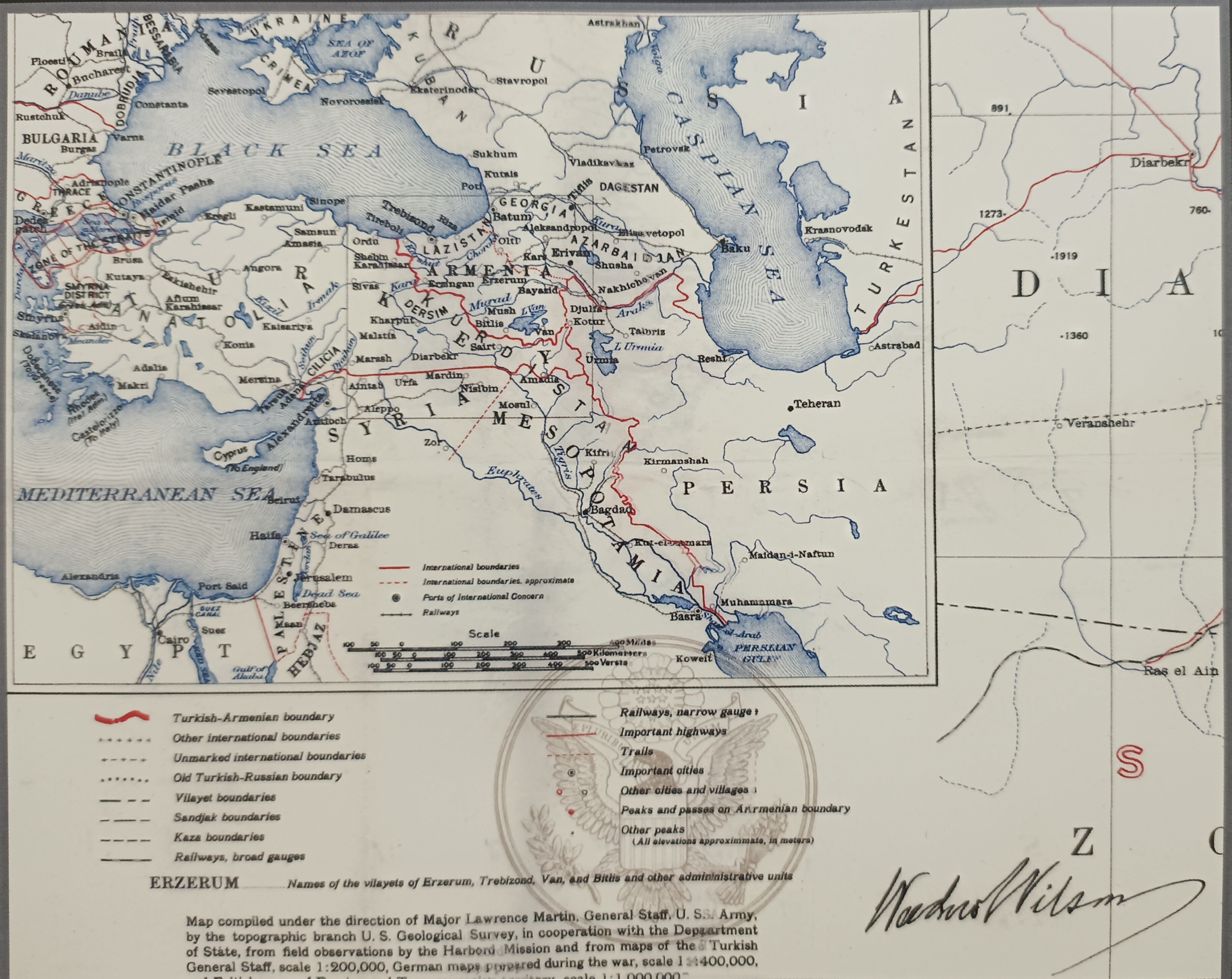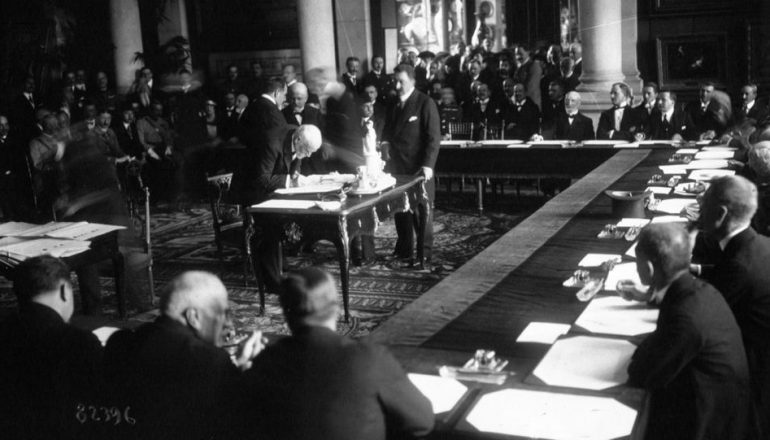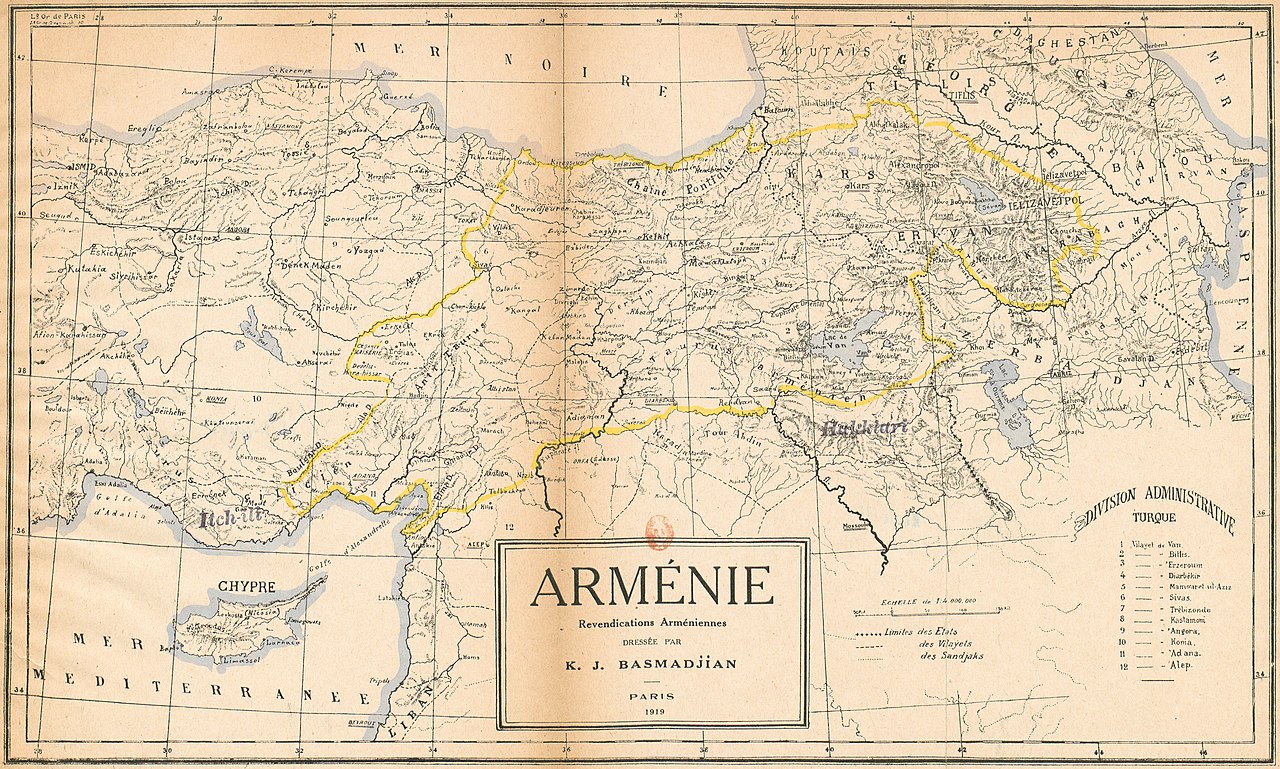

The Treaty of Sèvres (French: Traité de Sèvres) was a 1920 treaty signed between the Allies of World War I and the Ottoman Empire. The treaty ceded large parts of Ottoman territory to France, the United Kingdom, Greece and Italy, as well as creating large occupation zones within the Ottoman Empire. It was one of a series of treaties that the Central Powers signed with the Allied Powers after their defeat in World War I. Hostilities had already ended with the Armistice of Mudros.

Mehmed Hâdî Pasha signs the Treaty of Sèvres.

The First Republic of Armenia, with the western borders defined by US President Woodrow Wilson

21,000 soldiers and officers, Ohio, 1918

The treaty was signed on 10 August 1920 in an exhibition room at the Manufacture nationale de Sèvres porcelain factory in Sèvres, France.
The Treaty of Sèvres marked the beginning of the partitioning of the Ottoman Empire. The treaty's stipulations included the renunciation of most territory not inhabited by Turkish people and their cession to the Allied administration.
The ceding of Eastern Mediterranean lands saw the introduction of novel polities, including the British Mandate for Palestine and the French Mandate for Syria and Lebanon.
Treaty of Sèrves with zones of influence
France
Within the territory retained by Turkey under the treaty, France received Syria and neighbouring parts of southeastern Anatolia, including Antep, Urfa and Mardin. Cilicia, including Adana, Diyarbakır and large portions of east-central Anatolia all the way north to Sivas and Tokat, were declared a zone of French influence.
Greece
The Greek government administered the occupation of Smyrna from 21 May 1919. A protectorate was established on 30 July 1922. The treaty transferred "the exercise of her rights of sovereignty to a local parliament" but left the region within the Ottoman Empire. The treaty had Smyrna to be administered by a local parliament, with a plebiscite overseen by the League of Nations after five years to decide if Smyrna's citizens wished to join Greece or to remain in the Ottoman Empire. The treaty accepted Greek administration of the Smyrna enclave, but the area remained under Turkish sovereignty. To protect the Christian population from attacks by the Turkish irregulars, the Greek army expanded its jurisdiction also to nearby cities creating the so-called "Smyrna Zone".
Italy
Italy was formally given possession of the Dodecanese Islands, which had been under Italian occupation since the Italo-Turkish War of 1911–1912 despite the Treaty of Ouchy according to which Italy should have returned the islands to the Ottoman Empire. Large portions of southern and west-central Anatolia, including the port city of Antalya and the historic Seljuk capital of Konya, were declared to be an Italian zone of influence. Antalya Province had been promised by the Triple Entente to Italy in the Treaty of London,[16] and the Italian colonial authorities wished the zone to become an Italian colony under the name of Lycia.
Zone of the Straits
A Zone of the Straits was proposed to include the Bosphorus, the Dardanelles and the Sea of Marmara. Navigation would be open in the Dardanelles in times of peace and war alike to all vessels of commerce and war, regardless of flag. That would effectively lead to the internationalisation of the waters, which were not to be subject to blockade, and no act of war could be committed there except to enforce decisions of the League of Nations.
Free zones
Certain ports were to be declared to be of international importance. The League of Nations insisted on the complete freedom and the absolute equality in treatment at such ports, particularly regarding charges and facilities, to ensure that economic provisions in commercially-strategic places were carried out. The regions were to be called "free zones". The ports were Constantinople from San Stefano to Dolmabahçe, Haidar-Pasha, Smyrna, Alexandretta, Haifa, Basra, Trabzon and Batum.
Thrace
Eastern Thrace (up to the Chatalja line), the islands of Imbros and Tenedos and the islands of the Sea of Marmara were ceded to Greece. The waters surrounding the islands were declared international territory and left to the administration of the "Zone of the Straits".
Kurdistan
The Kurdistan region, including Mosul Province, was scheduled to have a referendum to decide its fate.
Armenia
Armenia was recognised as a "free and independent" state in Section VI "Armenia", Articles 88-93. By Article 89, "Turkey and Armenia, as well as the other High Contracting Parties agree to submit to the arbitration of the President of the United States of America the question of the frontier to be fixed between Turkey and Armenia in the vilayets of Erzerum, Trebizond, Van and Bitlis, and to accept his decision thereupon, as well as any stipulations he may prescribe as to access for Armenia to the sea, and as to the demilitarisation of any portion of Turkish territory adjacent to the said frontier".
British Mandate for Iraq
The details in the treaty regarding the British Mandate for Iraq were completed on 25 April 1920 at the San Remo Conference. The oil concession in the region was given to the British-controlled Turkish Petroleum Company (TPC), which had held concessionary rights to Mosul Province. British and Iraqi negotiators held acrimonious discussions over the new oil concession. The League of Nations voted on the disposition of Mosul, and the Iraqis feared that without British support, Iraq would lose the area. In March 1925, the TPC was renamed the "Iraq Petroleum Company" (IPC) and granted a full and complete concession for 75 years.
British Mandate for Palestine
The three principles of the British Balfour Declaration regarding Palestine were adopted in the Treaty of Sèvres:
French Mandate for Syria and Lebanon
The French Mandate was settled at the San Remo Conference and comprised the region between the Euphrates River and the Syrian Desert on the east and the Mediterranean Sea on the west, and it extended from the Nur Mountains in the north to Egypt in the south, an area of about 60,000 sq mi (160,000 km2) with a population of about 3,000,000, including the Lebanon and an enlarged Syria, both of which were later reassigned under a League of Nations Mandate. The region was divided under the French into four governments as follows: Government of Aleppo, from the Euphrates region to the Mediterranean; Great Lebanon, extending from Tripoli to Palestine; Damascus, including Damascus, Hama, Hems and the Hauran; and the country of Mount Arisarieh. Faisal ibn Husayn, who had been proclaimed king of Syria by a Syrian National Congress in Damascus in March 1920, was ejected by the French in July the same year. The next year, he became king of Iraq.
Kingdom of Hejaz
The Kingdom of Hejaz, on the Arabian Peninsula, was granted international recognition and had an estimated area of 100,000 sq mi (260,000 km2) and a population of about 750,000. The main cities were the Holy Places of Makka, with a population of 80,000, and Medina, with a population of 40,000. Under the Ottomans, it had been the vilayet of Hejaz, but during the war, it became an independent kingdom under British influence.






















